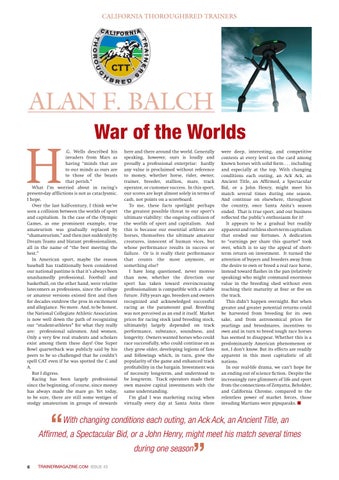CALIFORNIA THOROUGHBRED TRAINERS
ALAN F. BALCH War of the Worlds
H
.G. Wells described his invaders from Mars as having “minds that are to our minds as ours are to those of the beasts that perish.” What I’m worried about in racing’s present-day afflictions is not as cataclysmic. I hope. Over the last half-century, I think we’ve seen a collision between the worlds of sport and capitalism. In the case of the Olympic Games, as one prominent example, true amateurism was gradually replaced by “shamateurism,” and then (not suddenly) by Dream Teams and blatant professionalism, all in the name of “the best meeting the best.” In American sport, maybe the reason baseball has traditionally been considered our national pastime is that it’s always been unashamedly professional. Football and basketball, on the other hand, were relative latecomers as professions, since the college or amateur versions existed first and then for decades outdrew the pros in excitement and allegiance. No more. And, to be honest, the National Collegiate Athletic Association is now well down the path of recognizing our “student-athletes” for what they really are: professional salesmen. And women. Only a very few real students and scholars exist among them these days! One Super Bowl quarterback was publicly said by his peers to be so challenged that he couldn’t spell CAT even if he was spotted the C and A. But I digress. Racing has been largely professional since the beginning, of course, since money has always made the mare go. Yet today, to be sure, there are still some vestiges of stodgy amateurism in groups of stewards
here and there around the world. Generally speaking, however, ours is loudly and proudly a professional enterprise: hardly any value is proclaimed without reference to money, whether horse, rider, owner, trainer, breeder, stallion, mare, track operator, or customer success. In this sport, our scores are kept almost solely in terms of cash, not points on a scoreboard. To me, these facts spotlight perhaps the greatest possible threat to our sport’s ultimate viability: the ongoing collision of the worlds of sport and capitalism. And this is because our essential athletes are horses, themselves the ultimate amateur creatures, innocent of human vices, but whose performance results in success or failure. Or is it really their performance that counts the most anymore, or something else? I have long questioned, never moreso than now, whether the direction our sport has taken toward ever-increasing professionalism is compatible with a viable future. Fifty years ago, breeders and owners recognized and acknowledged successful racing as the paramount goal. Breeding was not perceived as an end it itself. Market prices for racing stock (and breeding stock, ultimately) largely depended on track performance, substance, soundness, and longevity. Owners wanted horses who could race successfully, who could continue on as they grew older, developing legions of fans and followings which, in turn, grew the popularity of the game and enhanced track profitability in the bargain. Investment was of necessity long-term, and understood to be long-term. Track operators made their own massive capital investments with the same understanding. I’m glad I was marketing racing when virtually every day at Santa Anita there
“
were deep, interesting, and competitive contests at every level on the card among known horses with solid form . . . including and especially at the top. With changing conditions each outing, an Ack Ack, an Ancient Title, an Affirmed, a Spectacular Bid, or a John Henry, might meet his match several times during one season. And continue on elsewhere, throughout the country, once Santa Anita’s season ended. That is true sport, and our business reflected the public’s enthusiasm for it! It appears to be a gradual but readily apparent and ruthless short-term capitalism that eroded our fortunes. A dedication to “earnings per share this quarter” took over, which is to say the appeal of shortterm return on investment. It turned the attention of buyers and breeders away from the desire to own or breed a real race horse, instead toward flashes in the pan (relatively speaking) who might command enormous value in the breeding shed without even reaching their maturity at four or five on the track. This didn’t happen overnight. But when greater and greater potential returns could be harvested from breeding for its own sake, and from astronomical prices for yearlings and broodmares, incentives to own and in turn to breed tough race horses has seemed to disappear. Whether this is a predominantly American phenomenon or not, I don’t know. But its effects are readily apparent in this most capitalistic of all nations. In our real-life drama, we can’t hope for an ending out of science fiction. Despite the increasingly rare glimmers of life and sport from the connections of Zenyatta, Beholder, and California Chrome, compared to the relentless power of market forces, those invading Martians were pipsqueaks. n
With changing conditions each outing, an Ack Ack, an Ancient Title, an
Affirmed, a Spectacular Bid, or a John Henry, might meet his match several times during one season 6
TRAINERMAGAZINE.COM ISSUE 43
”
